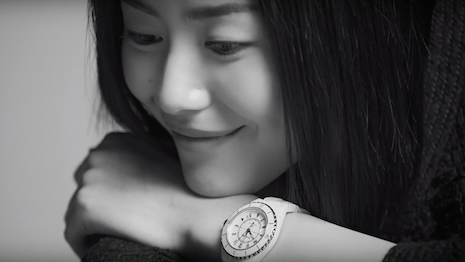Propelled by smartwatches, total watch sales jumped 17 percent in the 12 months ended June 2019, according to data from NPD Group.
With the number of consumers of all ages who say they wear a watch having grown since 2015, watch sales swelled to $9.5 billion in the last year. The number of consumers between 18 and 34 years old who prefer fine watches has also increased since 2015.
Luxury growth
Younger consumers and women of all ages are driving growth in the luxury watch segment.
Although 20 percent of 18- to 34-year-old consumers prefer wearing smartwatches, another 13 percent favor fine and fine Swiss timepieces. Sales of luxury women’s watches priced at $5,000 and above grew 8 percent year-over-year.

Smartwatches and fine Swiss timepieces remain popular among younger consumers. Image credit: Ulysse Nardin
While older consumers continue to dominate high-end watch sales, these shifts indicate positive growth for the segment.
“More U.S. adults are wearing watches today than four years ago, and that is a healthy trend for the entire industry,” said Reginald Brack, watches and luxury industry analyst at The NPD Group, in a statement. “Smartwatches have become the entry point for new watch consumers looking to make their own personal statements, creating opportunity for many traditional watch brands across all price points.”
Wearing a watch today is less about functionality and more about fashion and buying into a brand, enabling houses to differentiate themselves through marketing that centers on their unique history.
During a panel discussion hosted by the French American Chamber of Commerce and moderated by FACC president Elsa Berry, panelists from Ulysse Nardin and Watches of Switzerland spoke about how they are reaching out to younger and more trend-driven audiences. While watches got their start as tools, today that position is held more by devices such as fitness trackers and the Apple Watch, leaving room for both technology and haute timepieces (see story).
{"ct":"rNb8KvpIzgVwcWA6OGddaqBbqLwjZyXCznHE4KSeikQLo0SqGywBn0BifTjlcrZJq2xfea+zWN9tVpQnSvHF2swkQ0WqfmhJjhZKt6b7mBTOpJ3IKlYUaS3iivOXfkEI3SG11ky9LRXn3PeJ9zBTO1T9nKo0tw1i8u4YulQxhWc1tyDXR5GAaI1BUnDLzwONn1EjQKCZ1cxHXV4P1MviWxaG6xJTA1AVXHrffo9jAoHzXJJUbOrYMSz98E3wAXVY3visvWKAUVWewjKedWjJukBc+G+2UqydcLry29Wk+JGgt9EKP3PYDVCTOL3T2\/My86XehMUD\/IwBVEy8T0TzdMtZuE5ObOicGY1YEP7cl5jjy4BqGz5zGy0\/IU1nNaOCx5JlC08X0fXP4SWF68h9ktoo8+LJI58T+fjRTpfiGOZfEFCZl2jQ+NgjQIrSiBJb2ooOsCEIxANDMt5BRXi7DXQ9EBmKzF8QeS57j3MS3xWF35BIFBu5GpQrwUmIGGvqWLntzVZGKMiJz7B7yMNnHb54QFLQa2nLfZCaW9We6kk19UTLHWv6mp5LKoRy0P+7gb0hV6zIunWJB8bvpC02fY\/URdHRGVH28068+mLxCIVQUDTtKZdUXSbgUgA4Lw6mC6m3y3DTIghm9EyhXPjkoCE+BhgJdOCLJUcAgthCMMFG4JfW\/9RNSF0IPb2nacFFniG0blKmJOVTx67ITfmwMDvS7tAz77mgBu7uF7GGK1K\/UF0PSe9g8UreohIBYFNv2Yvq3GZrTS3cnXkdTFYwGtvY+HMlV7RmDayQnF9c3j0ZdhOIfce9SFak06VXJJftaz5+gnz3csxOl3RQs2Xsd6aU2yLieCyUd5zDY5Lw0wDCqPu9BSIsXPWkrjnOGZttGMVR7SIkmv6tdZnfpmKQa5m8+qOZDouXaYH1+vpt8zU2liY3F3zPGVXcYiT3fi8hjh6hOsO62BM5Qr0WTnxsR4MsAujtxE0V4YkDaZiRVMqfii0l9ABUxBRXd\/5VaMHcX3fS8tErYjA\/CTMTXlEdLk2QOBlutp7weXyXohIX2n2zLDAEIjLKVbH7mWm5iFbMKO+gYoyu6hzMZ65TmTvIAl31tt2h+Hs8AzF6BAi1A+\/XFAJu9ITdtfQX1kcJ7ixsZMjsSvfFJdvDJ1Xbb90wvDWhcte8R2scTCOZHBf9KHR3s0QpnbdNQ0NmHD+AjplsXoP0AygDvX6EatoemHfNMBVpp0ovTa01y9bJEIEpNdCHy32RFmnpqGycGauEHq0tI0ezRvo0mJkbctYWDgjYz42liDrEZ7LXkOROiZDfEgHeC7SgC+rIwotUQ+NXdQIG2o934hqQVgXJc7Zjho7a2WtruW\/jWIY6+1CkDKD39BIK7mk4A4lK\/p9HWk3PuWiQJ4ixRAda0tpIG\/ui2FJPa0RFQvX4sV2j\/S\/CbntG2FBN4RJuZTuxiH28gt4y1h7JWT1NXp4tHwCxf2s7FFdouFL9CMuXZrOAJ7ANqg3RgReHf89XQRjoy7dE8L6AAZxgyQMsrgWd4\/DiW5WFbrPq9np5SLwkR0AF6GvUkEZa++tc0L2MYdVaihKYkObm9HhiEoTmxWz8+IEQFghzZ4teQZd5dWmkgPgf+3ZU2WZVOtBjggWCNG91FAGgQtOHkXpc5qYmCPRSSml4IOARaOQ6WsmI9mWf3Yd8m\/wgsCx18i8Yl6dt4lMQEkyy2nu5mvMxSY4YCOVU+WtOO29DZ7VaI88BOIu+WXtY7eikv68+DGjIz0QcZEBrHa\/v7QYJE\/nHlHoSRZ4\/TKQTF03t9wCcFDPzQp0dJZQyQqvl6O3gVJ+KS9UUo8SiWSZzx2Ugykvkma8rxyy5grdxe4S1jUFAgYKCN0Du2xqp5BrCE1X\/a0\/KZjh9+Fp0hg+PANUKOz3z36ScEZFoeF6dkHKrxdynSfnfqDjencbifUVDOo7B1UeO0SUqbuJcQ7hmiNn0xbAp9\/f6jnqErzDSFTFSlNWyaklYnmlrZNHbV8O4m6UXjR\/wdJWObYcTsZC2\/b3Z4KUoVNsl3jcuDAmTyy9zN42sClvhay5hEiMw9DcblUbne5YVbZ8Ae\/QrxWmXXn\/dlhfXSZy++HPklRxpsZeh9PbiiqXFF0qbOfTPq8A9E0uXDRPl05sRRiBBKFqwyQnI1GAPBVVAXWq4gMxW1n0NxCUfsgVpETm7sQ3ontkwZHypOdBEZvuJ0vyJvuEKYqSPIhLitN9EuTaFecx3cLUSDLD58BuJ4xzQUyxjCFQmBEw9dN47skX\/Oah4LMjpvhUS13H4ZCwyKWf1XMWn93Ni+hO3DTnXFBsES\/H0Fs0GWb4v69U9zYLnOjUn1lrNN9FuGknaMJdeSS14q6bFa9xvG37kgyVcoyY2kb2IzMLBs48U3f7rIIfzvbEZmMrhNwfp0MU9eLzuVYCqTciEWsNp5\/d5C+13JJiJKQMlIN1PaqT7IItLVtRSK+ttAQQEMtYW1yBt4dW1l\/hraGRsLll\/qlcA7j60zPUI9HrT7AGW8G8CwtSvKWzcL2Y0T7mAJ+Yne0gUS9gq5H72x8qxQ4nv\/tbD3g3OEMSe7LcOcja0gDVHMx34hosqsI7bk4lVNnFWR3ynZbLQP11y4rQtySEfDGpvA9YdUmBzeBj5cpWbTrTOusxcj3EySc0qSxpjcIWOPvV12HOE+BTbfKCyu3hwjScrqPGPgEKDAWBOa60f\/bgwSpgmdZ9WjBWMez6KgnsE4oMW2VG7jekWL3h+bpxprPUVqYPcN1IUj4pAOTvzCO4wSj5pfn4WnyTspFlUHuysffwbVN\/Jpzb38Ma6ayAHT5tkYhTB0YY6OOCUMS1HQhQgupx1vTvFG7A+\/6jc+7wO4JSMD1cb743pXSkdLL5KV1jDI7VfX9qJK5lB5YZT01+ecsgVVPWgfqJmhielnHd379AG0b4G5Vp21k3VOv7tpp2mSA2Ygvtg9\/rsK3xplc5YtyxPstcmRmplQvT2mBlojKjp8yoMUAkTyWf\/pjFCuGFlZVOa\/K0h1mOa+cBpTSm8f\/jlr26ImIGyyt\/P3TjeDEMmfhOE56t3AyokFEl8lszYHRE9nLQgM8mnCkGhpXpZm36bQQfBlCLuOnISYepNabYPYPWPLMHewjoDG10Ed6KO21vrXYsa2LfWXn1vzMCBMTr4OCdJr3HRNUysb309qN5zHA46nY3b2x7rUgGeYDWZvxrnfTbWrqxYRCD0EEWGzCrv89KypfdnmNg9xNFDZwrrPWKb6i\/6a9iRVMFCacwxsFoe7kNUuzDwQf\/rvOb5Wlp62M8QWxuEtNv0zNB09J9M7xQCdKcrAiNaow5EWEPPGcqOdaeK3XBleJjINhd1c21yMDsFbDF1p\/f1g4+dlHmG9iase1fyM9MNJvIV0GNTTOs+hxNjyeNOZ8tW4NBiVW0bRUIEDTqcRvGq2QM7YrWBj\/VInnccKM516dkRkDiMqBIEiC49GOJQO\/F5Inu3SOY=","iv":"e3ead2d46e8986f2846c0e20a45f2c0a","s":"f1f7a5f01abf407b"}

 Women are buying more luxury timepieces than in the past. Image credit: Chanel
Women are buying more luxury timepieces than in the past. Image credit: Chanel